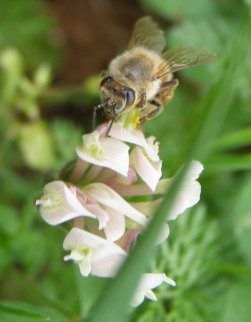Bees rely on the biological clock to time their arrival at flowers at times when nectar and pollen are at their peak. Bees can learn to reach flowers at nine different time points during the day and precisely in about 20 minutes

In a groundbreaking study conducted by a research group led by Dr. Guy Bloch from the Faculty of Mathematics and Natural Sciences at the Hebrew University, it was found that the molecular structure of the honey bee's biological clock is more similar to the biological clock of mammals than to the biological clock of flies.
In the study, the central genes of the bee's biological clock were identified and characterized. The research findings will be published tomorrow, on October 26.10, in the prestigious scientific journal Nature (and on November 1.11 - in the Genome Research journal).
The biological clock is an internal system in the body of living beings that creates a "circadian rhythm". The term is derived from the Latin term circa dies, which means "about one day". The length of a circadian cycle is about 24 hours, and its great importance lies in its ability to monitor many processes, for example: the hours of wakefulness and fatigue, the daily rhythm of activity and cyclical changes in body temperature and hormone secretion.
Bees rely on the biological clock to time their arrival at flowers at times when nectar and pollen are at their peak. Bees can learn to reach flowers at nine different time points during the day and precisely in about 20 minutes. The watch is also essential for accurate navigation with the help of the sun, since the sun moves during the day from east to west. Bees, whose body length is a little more than one centimeter, are able to navigate with the help of the sun towards concentrations of flowers that are more than ten kilometers from the hive.
The central biological clock is located in the brain and consists of a group of clock cells, each of which is able to produce a circadian rhythm independently. The circadian rhythm is created by the activity of clock proteins that accumulate in the cell and cause their production to stop; The time from the start of production of the clock proteins until their breakdown and production stop is about 24 hours. The genes isolated in the research of Dr. Bloch and his associates are responsible for this process in bees.
The research by Dr. Bloch and his team is part of a global project to sequence the genome of the honey bee (similar to the human genome project that was completed several years ago). According to him, "Surprisingly, it was found that the molecular structure of the biological clock in bees is more similar to the clock in mammals than to the clock in flies. These results change the understanding of the evolution of circadian clocks since it was common to think that there was a type of clock characteristic of insects and another type of clock characteristic of mammals."
Dr. Bloch points out that the discovery raises many questions regarding the evolution of biological clocks and the importance of differences in the organization of the clock in different organisms. For example, why is a bee's clock more like a human's clock than a fly's clock? Is the similarity between bees and mammals related to the complexity of behavior in bees? How was the clock of ancient insects built? Was it more like that of the bee or that of the fly?
The characterization of the genes in the bee's clock opens up new research directions concerning the understanding of the molecular basis of complex behaviors such as navigation with the help of the sun, learning time, flexibility in the rhythm of activity and social control of the circadian clock system. In addition to this, it is very important to study the evolution and activity of circadian clock genes since recently published studies show their involvement in a variety of diseases such as: mental illnesses, alcoholism, obesity, drug addiction and aging.
